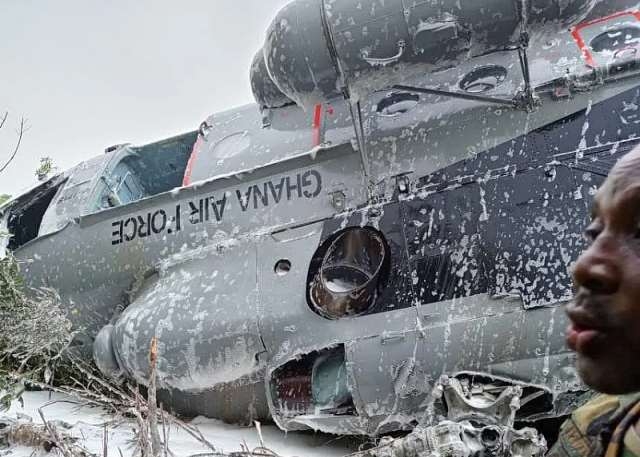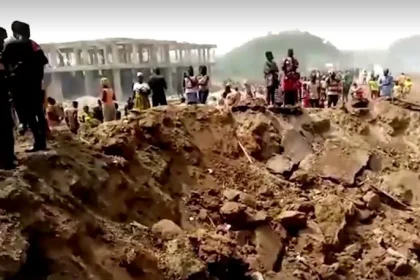The government of Ghana has released the final report on the military helicopter crash that claimed the lives of eight people, including two Cabinet ministers, confirming that the accident was caused primarily by poor weather conditions and a sudden downdraft over hilly terrain.
The tragic crash occurred on August 6, 2025, when a Ghana Air Force Harbin Z-9 helicopter carrying senior government officials and crew members went down in the Dampia Range near Antoakrom in the Amansie West District of the Ashanti Region. There were no survivors.
The aircraft had taken off from Kotoka International Airport in Accra, bound for Obuasi. On board were the Minister of Defence, Dr. Edward Omane Boamah; the Minister for Environment, Science, Technology and Innovation, Ibrahim Murtala Muhammed; Acting Deputy National Security Coordinator Limuna Muniru; National Democratic Congress Vice Chairman Samuel Sarpong; and the Deputy Director-General of the National Disaster Management Organisation, Samuel Aboagye. Three Ghana Air Force crew members were also aboard.
The helicopter lost radar contact less than 20 minutes after take-off. Search and rescue teams later found the wreckage in a densely forested area, badly damaged and burned. The crash sent shock waves across the country and triggered three days of national mourning.
The official investigation, led by the Aircraft Accident and Incident Investigation Bureau (AIB), was supported by international experts. It concluded that the helicopter encountered rapidly deteriorating weather, including mist, low clouds, and light rain that reduced visibility to under 200 meters. Investigators found that while the flight began under Visual Flight Rules, the aircraft inadvertently entered instrument flight conditions without adequate navigation systems to cope with the change.
The report said the helicopter suffered a sudden loss of lift caused by a downdraft as it flew over rising terrain, forcing it into a ridge at about 1,370 feet above sea level, roughly six miles from its intended destination. The pilots were experienced, properly certified, and found to have been in good physical condition. There was no evidence of fatigue, intoxication, or mechanical failure.
The aircraft was declared airworthy but lacked some critical modern safety features such as a terrain awareness and warning system, enhanced navigation aids, and an autopilot backup. These, investigators noted, might have given the pilots enough situational awareness to avoid the fatal descent.
The head of investigations at AIB Ghana, Captain Paul Forjoe, explained that while the weather was the main factor, the tragedy also reflected systemic safety gaps. He said the probe “found no negligence on the part of the flight crew,” but highlighted “the urgent need to improve flight safety procedures, equipment standards, and weather monitoring for state transport operations.”
The government, in response to the findings, pledged to upgrade the Ghana Armed Forces’ aviation systems and to review all flight protocols for missions involving public officials. The Ministry of Defence also announced plans to install advanced terrain-warning systems on its aircraft and to strengthen pilot training on weather-related risk management.
President John Dramani Mahama, who led the nation in mourning, described the accident as “a national tragedy that must never happen again.” He said the government would fully implement the recommendations to ensure “our skies are safer and our public servants are better protected in service to the nation.”
The crash reignited public debate over the safety of official air travel in Ghana. The deaths of two key ministers—both described as hardworking and reform-minded—left critical gaps in the government’s operations. Dr. Omane Boamah had been leading defence modernization efforts, while Murtala Muhammed was spearheading climate and clean-energy initiatives.
In Parliament and across the media, calls have grown for a comprehensive safety review of all government aircraft. Aviation analysts have pointed to the need for stricter weather protocols, improved maintenance oversight, and better coordination between civil and military aviation authorities.
The release of the final report was seen as an important act of transparency. Previous military crashes in the region have often remained shrouded in secrecy, but the public nature of this report has drawn praise from civil society and aviation safety advocates.
In its closing remarks, the investigative panel underscored that while technology and training can reduce risks, accountability and procedural discipline are equally vital. “Flying government officials in challenging weather requires not just technical readiness but institutional diligence,” the report stated.
The findings have brought some closure to the families of those lost, though they also highlight the fragility of Ghana’s aviation infrastructure. The report makes clear that without urgent reforms—upgrading aircraft, enforcing weather limitations, and strengthening oversight—the lessons of August 6 could be forgotten.
For now, the government says its priority is to implement all the recommendations and ensure that the tragic loss of life leads to a safer, more resilient aviation system. The memory of the eight who perished, officials say, will serve as a permanent reminder of what must change in Ghana’s skies.






